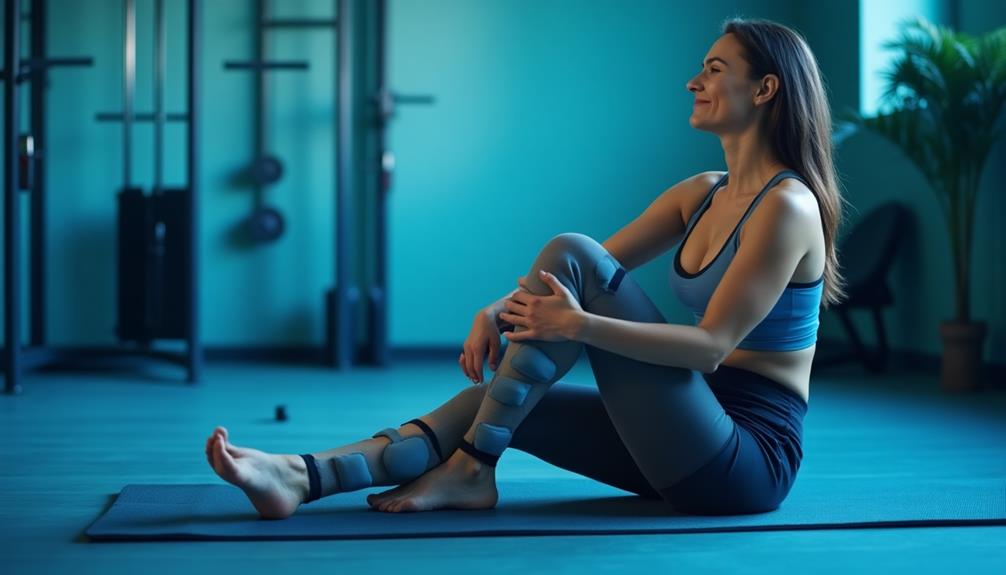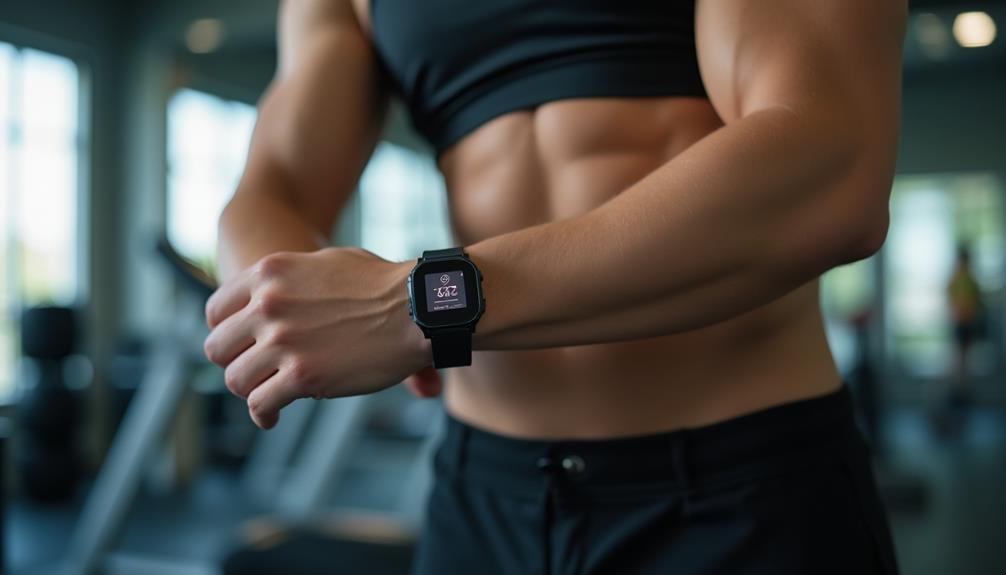To reduce delayed onset muscle soreness (DOMS) and enhance your recovery, start by hydrating adequately before, during, and after workouts. Prioritize nutrition with protein and carbohydrates shortly after exercise, and include healthy fats and antioxidants. Incorporate both static and dynamic stretching to maintain flexibility. Utilize foam rolling to improve circulation and reduce tension in sore muscles. Cold therapy, like ice packs for 15-20 minutes, can minimize inflammation. Consider active recovery, compression gear, and massage therapy, while also monitoring your workout intensity. Want to discover more effective recovery strategies? Keep exploring for additional insights!
Core Insights
- Stay well-hydrated before, during, and after workouts to reduce muscle soreness and aid nutrient transport for recovery.
- Prioritize protein and carbohydrates post-workout to support muscle repair and replenish energy stores effectively.
- Incorporate both static and dynamic stretching to maintain flexibility and promote blood flow for faster recovery.
- Utilize foam rolling post-exercise to improve circulation, reduce soreness, and enhance flexibility by targeting tender muscle spots.
- Apply cold therapy within 24 hours post-workout to reduce inflammation and numb pain effectively.
Hydrate Adequately

To effectively combat delayed onset muscle soreness (DOMS), you can't overlook the importance of hydration. Staying well-hydrated before, during, and after your workout can greatly reduce muscle soreness. Water helps transport nutrients to your muscles, aiding recovery and minimizing stiffness. Aim to drink at least 16-20 ounces of water in the hours leading up to your workout, and replenish with another 8-10 ounces right after. For best hydration, consider incorporating electrolyte-rich coconut water into your post-workout routine, as it offers natural electrolytes and potassium to support muscle recovery.
During intense exercise, consider sipping on an electrolyte-rich drink to replace lost minerals. It's crucial to listen to your body; if you feel thirsty, you're already slightly dehydrated. Post-workout, make it a habit to hydrate fully, ensuring your muscles have what they need to recover effectively. Remember, proper hydration is a key step in reducing DOMS.
Prioritize Nutrition

Nutrition plays a crucial role in your recovery process and can greatly impact the severity of DOMS. Consuming the right nutrients helps repair muscle tissue and reduces inflammation. Focus on protein, as it aids in muscle repair. Aim for a source of protein within 30 minutes after your workout.
Carbohydrates are equally important. They replenish glycogen stores, providing energy for your next workout. Consider using fast-acting carb powders to quickly restore energy levels and support excellent recovery. Incorporate healthy fats, like avocados and nuts, which have anti-inflammatory properties.
Don't forget about vitamins and minerals. Foods rich in antioxidants, such as berries and leafy greens, can help combat oxidative stress.
Incorporate Stretching

Incorporating stretching into your post-workout routine can greatly alleviate the effects of DOMS. Stretching helps maintain flexibility and promotes blood flow to your muscles, which can speed up recovery. After your workout, take a few minutes to focus on both static and dynamic stretches. Consider supplementing with L-Glutamine to further support muscle recovery and reduce soreness. This amino acid has been shown to aid in muscle repair and growth.
Start with dynamic stretches to loosen up your muscles, like arm circles or leg swings. Then, move to static stretches, holding each position for 15-30 seconds. Pay extra attention to the muscle groups you targeted during your workout.
Don't rush through this process; it's essential for allowing your muscles to recover effectively. By making stretching a priority, you'll not only reduce soreness but also improve your overall performance in future workouts.
Utilize Foam Rolling

| Benefits of Foam Rolling | How to Foam Roll |
|---|---|
| Reduces muscle soreness | Start slow, apply gentle pressure |
| Improves circulation | Roll on each muscle group for 1-2 minutes |
| Increases flexibility | Focus on tender spots, breathe deeply |
To get started, choose a foam roller and find a comfortable spot. Roll over each muscle group, pausing on tender areas. Incorporate this practice into your post-workout routine, and you'll likely notice a reduction in soreness and improved recovery.
Apply Cold Therapy

Applying cold therapy after your workout can greatly ease post-exercise muscle soreness. This method, often referred to as cryotherapy, helps reduce inflammation and numbs pain. You can use ice packs, cold towels, or even take an ice bath.
To start, apply the cold source directly to the sore muscles for about 15 to 20 minutes. Be sure to wrap ice packs in a cloth to prevent skin damage.
If you're using an ice bath, immerse your body for 10 to 15 minutes, ensuring the water is cold, but not painfully so.
Cold therapy works best when used within 24 hours after exercising. By incorporating this simple technique, you'll likely notice reduced muscle soreness and a quicker recovery time.
Get Sufficient Sleep

Restful sleep is crucial for muscle recovery and can greatly reduce delayed onset muscle soreness (DOMS). When you sleep, your body repairs muscle tissue and replenishes energy stores. Aim for 7 to 9 hours of quality sleep each night to optimize these benefits.
Establish a consistent sleep schedule by going to bed and waking up at the same time daily. Create a soothing bedtime routine, such as reading or meditating, to signal your body it's time to wind down. Limit exposure to screens and bright lights before bed, as they can disrupt your sleep cycle.
Lastly, ensure your sleep environment is cozy, peaceful, and dim. These steps help you achieve deep, restorative sleep, ultimately aiding in your post-workout recovery.
Consider Active Recovery

Incorporating active recovery into your post-workout routine can greatly help alleviate DOMS. Instead of completely resting, consider engaging in low-intensity activities that promote blood flow and aid muscle recovery. Here are three effective options:
- Light Walking: A brisk walk can increase circulation without straining your muscles.
- Gentle Stretching: Stretching helps maintain flexibility and reduces stiffness in sore muscles.
- Easy Cycling: Riding a stationary bike at a low intensity can keep your legs moving while minimizing discomfort.
Active recovery not only enhances your recovery process but also prepares your body for future workouts. So, don't overlook these gentle activities; they can make a significant difference in how you feel after intense training sessions.
Use Compression Gear

Active recovery methods like light walking, gentle stretching, and easy cycling can greatly enhance your post-workout experience, but don't underestimate the benefits of compression gear.
What is Compression Gear?
Compression gear includes items like sleeves, socks, and leggings designed to fit snugly around your muscles.
How It Helps
Wearing compression gear post-workout can improve blood circulation, which aids in nutrient delivery and waste removal. This means your muscles can recover faster, potentially reducing soreness.
When to Use It
You can wear compression gear during workouts or afterward. Many athletes find that using it post-exercise maximizes recovery benefits.
Incorporating compression gear into your recovery routine is a simple yet effective way to help manage DOMS and enhance your overall performance.
Explore Massage Therapy

- Enhanced Recovery: Massage helps accelerate the healing process by promoting nutrient delivery to your muscles.
- Pain Relief: It can notably reduce muscle soreness and discomfort, allowing you to get back to your workouts sooner.
- Improved Flexibility: Regular massages can boost your range of motion and prevent stiffness.
Incorporating massage therapy into your post-workout routine can lead to more efficient recovery, making it an essential tool for managing DOMS.
Monitor Workout Intensity

Start by tracking your workouts. Use a rating scale to gauge your effort, aiming for a level that feels tough but sustainable. Gradually increase intensity over time, allowing your body to adapt. Incorporate rest days and lighter workouts to give your muscles a break.
Listen to your body; if you feel persistent soreness, scale back. This approach will help you enjoy your workouts while minimizing the risk of DOMS, keeping you on track for your fitness goals.
Frequently Asked Questions
How Long Does DOMS Typically Last After Intense Workouts?
DOMS usually lasts between 24 to 72 hours after intense workouts. You might feel soreness peaking around the second day, but don't worry; it gradually subsides as your muscles recover and adapt.
Can Certain Supplements Help Reduce DOMS Symptoms?
Sure, you could pop a pill and hope for magic, but hey, supplements like omega-3s or branched-chain amino acids might actually help. Just don't skip the basics—hydration and stretching still matter, right?
Is It Normal to Experience DOMS Every Time I Work Out?
Yes, it's normal to experience DOMS after workouts, especially if you're trying new exercises or increasing intensity. Your muscles need time to adapt, so don't worry; this discomfort usually indicates progress in your fitness journey.
What Types of Exercises Are Most Likely to Cause DOMS?
Did you know that about 70% of people experience DOMS after intense workouts? Exercises like heavy squats, deadlifts, and eccentric movements are most likely to cause it, so be prepared for some soreness afterward!
Can I Still Exercise With Severe DOMS Pain?
You can still exercise with severe DOMS pain, but listen to your body. Opt for low-impact activities like walking or gentle stretching instead of intense workouts to avoid further injury and promote recovery.

